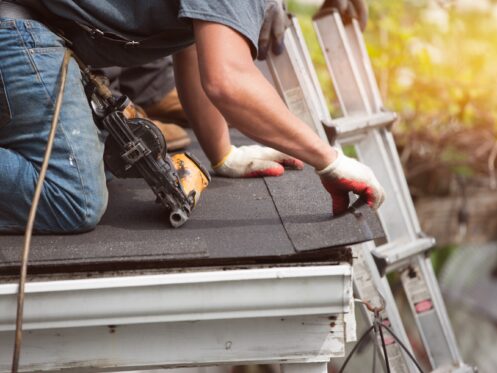As with most components in and around your home, your roof has a limited useful life. This means it will need to be replaced at some point. For instance, an asphalt shingle roof will last for about 20 years before its ability to protect against the elements diminishes. Other materials, such as metal, clay tiles or wood, may last longer as long as properly maintained.
The Roof Is Inspected
The first step in the roof replacement process is an inspection. This will ensure that there isn’t any damage beneath the shingles that will need to be addressed along with the shingles themselves. In some cases, a minor or hidden leak can cause the roof decking to rot or develop mold or mildew growth, or a fallen branch can cause damage that might not be noticeable on the shingles. Overflowing gutters can also cause water damage to the roof deck, which makes it critical that your entire roof is carefully examined before simply replacing the shingles.
Essentially, the inspection will reveal the extent of the project, which will make it easier to generate a more accurate quote. Of course, there is a chance that issues could still be discovered once the project gets going.
Choose Your Preferred Materials
After the inspection, your contractor will talk about how you want the roof to look and feel. You’ll likely have a range of materials to choose from as well as various colors you can pick. Typically, contractors offer samples that you can hold up to your home or a computer program to allow you to see what a given material or color will look like on your home.
Get a Projected Start Date
After you agree to have a new roof put on your home, you’ll get a projected start date. The start date depends largely on how much work your contractor currently has, the size of your project and weather conditions in your area.
In addition, the roof’s condition will also likely determine when your project starts. For example, if there’s a huge hole in the roof because a tree fell through it, your house could get priority over others on the schedule.
Generally speaking, timely service is easier to access in the early spring or fall as fewer people are looking to have this service performed. The summer months may also be an ideal time to have a roof replaced because this is a time when homeowners may be more likely to go on vacation or tend to other matters. During the winter, colder temperatures, shorter days, and ice and snow can make roof replacements tougher to complete on time. However, you can still get a new roof installed in the winter if needed.
Old Materials Are Removed
The existing shingles are removed so that the decking is exposed. At that time, a more thorough inspection of the decking can be completed to ensure there are no weak spots or other areas of concern. If there are, those areas will need to either be replaced or reinforced to ensure that the new materials can be applied properly.
Existing shingles and other materials removed from the roof are placed into a dumpster on your property. Ideally, whoever works on your roof will do an inspection each day to check for nails or other sharp objects that shouldn’t be left on your lawn.
Alterations Are Made if Necessary
If you are switching from an asphalt shingle roof to another material, your home may need to be reinforced to handle the extra weight. This could include increasing the slope to spread the extra weight evenly among the entire structure.
New Shingles Are Placed on the Roof
After the old shingles are removed and the decking is inspected, the new shingles are ready to be put on. They are typically installed with nail guns or similar tools that ensure consistent application and cut down on the amount of time spent on this task. Spot checks will ensure that shingles are in good condition before they are nailed into place.
Flashing and Waterproofing Elements Are Installed
There are several vulnerable areas on the roof, such as the edge, around the chimney and around vents. Securing these vulnerable areas minimizes the risk of water, pests or other types of damage that could spread throughout the rest of your house and compromise critical components.
A Final Check Is Completed
After your new roof is installed on your home, a final check will be done to make sure that shingles, flashing and other materials were applied properly. You will have a chance to look at the final result and give your final seal of approval. If you do have any questions or concerns, don’t be afraid to voice them. Speaking up while the contractor is on site makes it easier to have any problems that you discover corrected appropriately.
How to Pay for a Roof Replacement
In most cases, half of the project cost is due upfront while the other half will be due upon completion. It may be possible to pay in cash, with a credit card or by some other means. You can talk to your preferred service provider about payment options before signing a contract.
Don’t Forget About Gutters and Downspouts
A roof replacement may give you an opportunity to replace your old gutters or downspouts. Like the roof itself, these components also have a limited useful life. Furthermore, newer gutters tend to be made from stronger materials and are installed in a single piece instead of in sections.
Old Age Isn’t the Only Reason to Replace the Roof
Just because a roof hasn’t reached the end of its useful life doesn’t mean that it doesn’t need to be replaced. For instance, if shingles were not properly installed, they may need to be removed and replaced. The same might be true if flashing wasn’t installed correctly or at all.
If your roof already has two layers of shingles on it, you’ll need to have them torn off. If a third layer is placed on top of existing material, it could make the roof too heavy for the house to support. In fact, you could also need to have the roof replaced if the second layer of shingles isn’t properly installed on top of the first.
Ultimately, it’s a good idea to have your roof inspected once a year to make sure everything is in good condition. In some cases, early detection of moisture or other issues might allow you to opt for a repair instead of a full replacement.
At Emerald Roofing in Omaha, we can repair, replace or maintain a roof with ease. We’ll also be able to help with any issues that you’re having with your home’s siding or gutters. Give our team a call today to request a quote or to schedule service to have your home restored to pristine condition.
Contact Emerald Roofing today!

